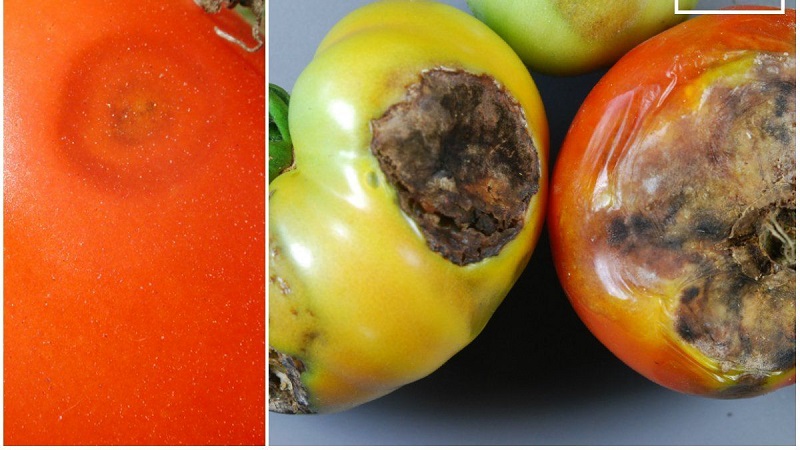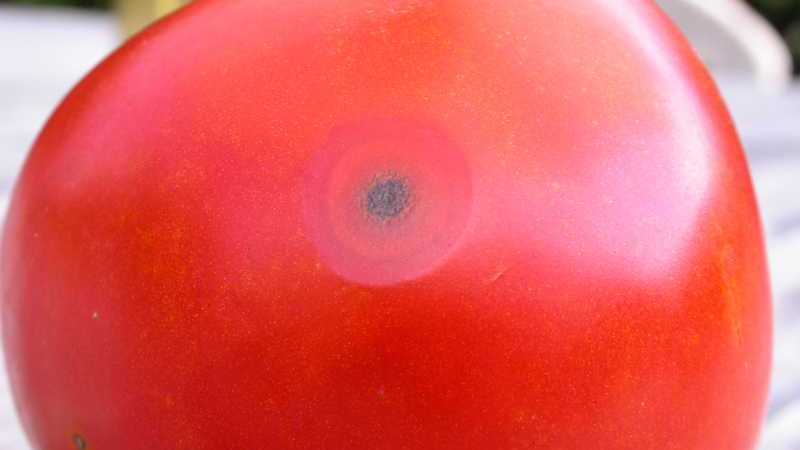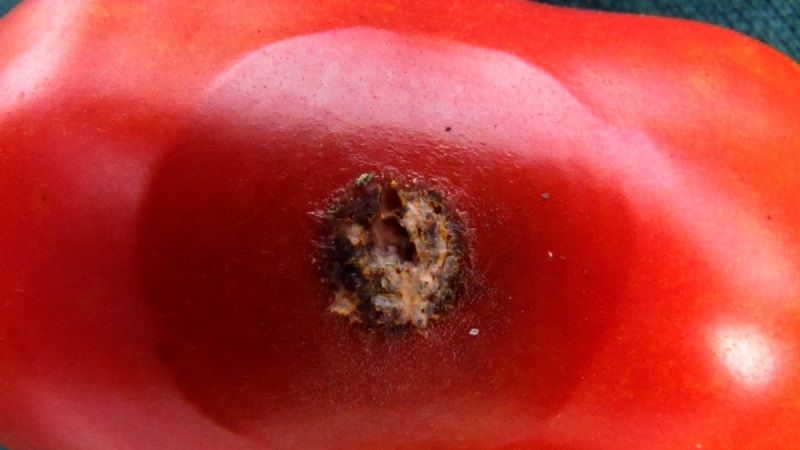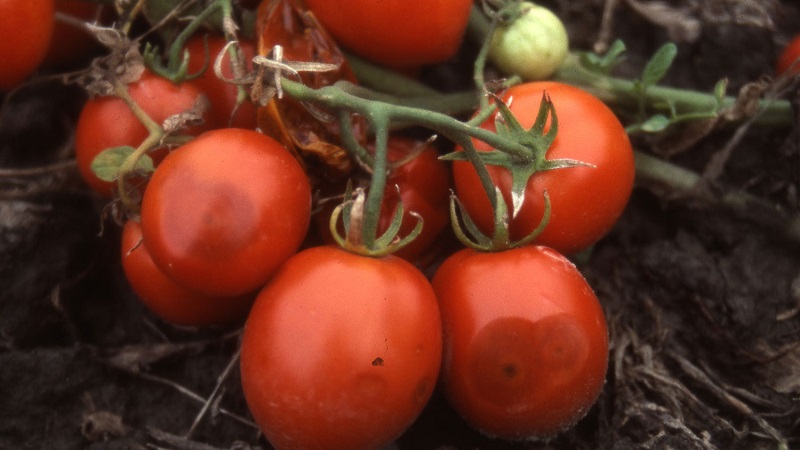Why tomato anthracnose is so terrible: we study the disease and effectively fight it ourselves
Novice gardeners are often faced withdiseases tomatoes. In such cases, it is important not to waste time for the fight, otherwise the entire crop may die. This article will focus on a common disease - tomato anthracnose. What kind of disease is it, can it be cured and what preventive measures exist? Check out the tips of experienced summer residents and photos of plants infected with anthracnose in our article.
The content of the article
Anthracnose - what is this disease
This fungal disease, caused by Colletotrichum pathogens, is more common in mature and overripe tomatoes. It can spoil the presentation of the fruit and even destroy the entire crop.
Most often, anthracnose develops in regions with high humidity both in the open field and in film greenhouses. It affects tomatoes, potatoes, cucumbers, pepper, eggplant, melons, shrubs and fruit trees. Can be massive.

How does it affect tomatoes
The photo shows that the fruits of a tomato infected with anthracnose lose their attractive appearance. Stains of various shapes appear on them, under which rotting and destruction of tissues occurs.
Formations can acquire a dark color due to the fact that hairs begin to appear on the body of the pathogenic fungus. When cutting the fruit, a mucous, jelly-like mass of pink color appears, containing spores of a microorganism.
Important! The disease can also affect green fruits.
Description of symptoms and external signs
Anthracnose is of two types: affecting leaves or fruits. At risk are plants that have mechanical damage, through which the fungus enters.
The causative agent of green mass disease is a fungus Colletotrichum atramentarium, adult plants suffer from it. First, the upper leaves wilt and the roots weaken, the tomato can be pulled out without difficulty. Small black sclerotia appear on the diseased plant, while the central cylinder is exposed.
Fruit anthracnose cause mushrooms Colletotrichum phomoides.
The disease can be recognized by the following external manifestations:
- the appearance on ripe fruits of spots of various shapes with a diameter of 5-15 mm;
- darkening of the affected areas;
- the formation of pink sporulation on the spots;
- decay and destruction of fetal tissue.
Reference. The disease affects only those fruits that touch the ground, the crop on the upper branches remains intact.
A diseased fetus may be re-infected. This happens when cracks appear in damaged areas that contain fungal spores.
The fungus also penetrates into green fruits, in which case the disease manifests itself after harvest. When cleaning the site, you need to pay attention to the stems and foliage of tomatoes: if the plant is sick with anthracnose, then small lesions will remain on it.
Important! Can't use infected seed, otherwise grow the fungus along with the tomato.
As they ripen, small round and depressed spots will form on the green fruits, which will later turn dark in color.

Reasons for the appearance and infection
The infection spreads very quickly throughout the site. It affects not only tomatoes, but also other crops. Often, the manifestation of anthracnose can be seen on fruit plants.
Causative agent of the disease
Favorable conditions for the life of the fungus are moderate air temperatures up to 30 degrees and high humidity. Fruits with reduced disease resistance are susceptible to anthracnose.
Factors contributing to the development of the disease are lack of phosphorus and potassium and an increase in soil pH.
Terms of distribution
The disease is transmitted through gardening tools, containers, plant remains, seeds, and is also carried by insects. The lowered air temperature does not kill the fungus - it hibernates in the ground. It spreads through rain, wind, dew andwatering.
The pathogen is especially dangerous during periods when the fruits and leaves of the plant remain wet for a long time - in late summer and autumn.
How and what to treat
If diseased plants are found, the infected areas must be removed and burned. Then treat the rest of the bush with the fruits with drugs.
Chemicals
Anthracnose is a fungal disease in which fungicides are used. Every year the number of drugs increases, some of them are banned due to the presence of hazardous compounds.
The most effective remedies:
- "Kuproksat";
- Oxyhom;
- "Acrobat MC";
- Ridomil Gold;
- "Poliram";
- "Tiovit Jet";
- "Previkur";
- "Speed".
Hay sticks are also suitable for the treatment of tomato anthracnose. Diseased plants can be sprayed with the Polyram solution: 2.53 kg will be needed per hectare. A good result is also observed when using Cumulus DF.
Do not expect the disease to be defeated in one treatment: the procedure will need to be carried out 2-3 times with an interval of one week. So that the causative agent of the disease does not get used to the active composition of the drug, you can change the drugs.
More gentle means will help to slow down the spread of anthracnose: "Gamair" and "Fitosporin-M".

Traditional methods
You can try to save the crop with the help of copper oxychloride: 40 g of the substance is dissolved in 10 liters of water. You can also use 1% Bordeaux mixture or colloidal sulfur.
Agrotechnical techniques
You can resist the disease and reduce the rate of its spread if you loosen the soil every time you finish irrigation and after rain.
It is also necessary to alternate cultures. It is recommended to plant tomatoes in their original place only after 3-4 years.
Preventive measures
General phytosanitary methods are used in the prevention of anthracnose. To do this, you should:
- purchase seed from trusted producers;
- before planting, treat the seeds with fungicides or warm them up;
- observe crop rotation;
- regularly remove weeds and plant residues from the site;
- do not over-flood the plant;
- ventilate the greenhouse regularly;
- do not neglect the garter of plants;
- treat seedlings with fungicides;
- disinfect garden tools;
- to harvest during the period of expert maturity, avoiding overripening;
- while growing fruits, try to avoid mechanical damage;
- store the crop at a temperature of 5-6 degrees.

Gardener tips
One of the preventive measures is timely harvesting. How to determine the maturity of a tomato? Expert maturity is the period when redness in the form of a star appears at the top of the fetus.
In regions with high humidity, many gardeners prefer anthracnose-resistant varieties: LSL hybrids F1 Life, Shelf, Longf.
Before planting, you can soak the seeds in drug solutions "Agat-25" (7 g / 1 kg) or "Immunocytofit" (2 ml / 1 kg). During the growing season, it is advised to spray with "Novosil", and at the time 2-3 leaves appear - "Agatom-25" (14 g of the product will be needed per 1 hectare).
For prevention use drugs "Quadris", "Strobi" and 1% solution of Bordeaux mixture.
Important! To treat the greenhouse, use bleach: 200 g of the substance must be dissolved in 10 liters of water.

Conclusion
Anthracnose is a dangerous disease that makes tomato fruits unusable.Most often, the disease affects plants grown in greenhouses. It is much easier to make an effort to prevent a disease than to try to cure it.
A novice gardener should not neglect general phytosanitary measures: they can protect the crop not only from anthracnose, but also from other dangerous diseases. If the disease is caught by surprise, it is necessary to burn the spoiled bushes, and treat healthy plants with effective chemicals.